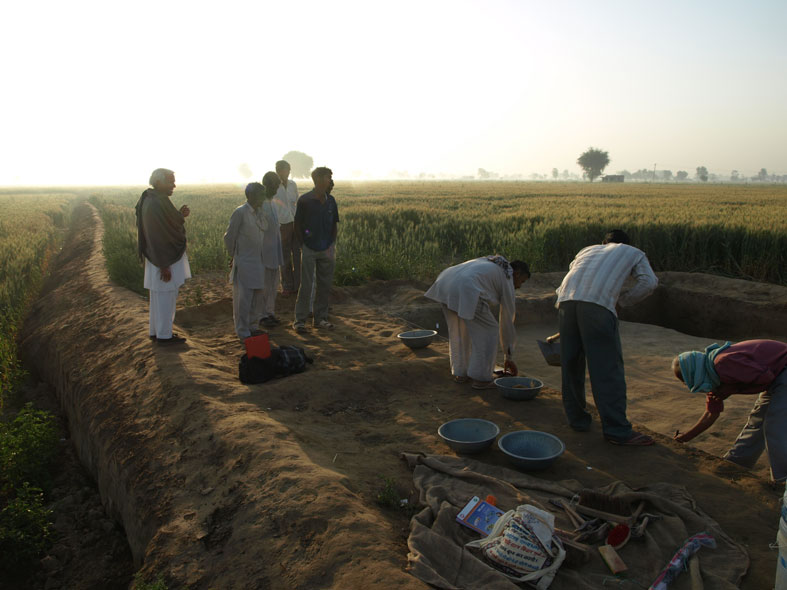Survey and excavations at Dabli vas Chugta, Hanumangarh, Rajasthan
The 2011 archaeological field research was comprised of survey and excavations at the site of Dabli vas Chugta, Hanumangarh, Rajasthan. This work included geomorphological survey of selected areas in Rajasthan.
The plains of northern Rajasthan are relatively flat and large areas have low undulations that are often barely perceptible on the ground. There are also large areas that are dominated by either solitary dunes or dunes that are a part of chains. The other major feature of northern Rajasthan is the broad trace of a palaeochannel that is readily visible on satellite imagery. The landscape to the north and south of this channel is clearly marked by the presence of loose wind blown sands, whereas the soils in the channel belt itself are today being used extensively for agriculture and show signs of being considerably more developed.
In order to gain a greater understanding of the surface and immediately subsurface geomorphology, a preliminary analysis of the environmental and landscape context of a range of archaeological sites in District Hanumangarh was carried out during the season. This saw a small team of researchers make assessments of the environmental and landscape context at Dabli vas Chugta and several other sites. This site margin survey work took the form of judgmentally placed test pits and hand auger profiles, as well as opportunistic findings of exposed and available sections, brick quarry pits, wells and water boreholes. At no point did this investigation intrude on land protected by the ASI. The primary objective of this work was to investigate the local soil and site-formation processes at each of these sites. At each profile loci, the stratigraphy was recorded and photographed, located and leveled in using a Leica GPS1200 differential GPS system, and old land surfaces sampled as appropriate.
Knowledge of the archaeology of northern Rajasthan is dominated by the excavations at two sites, the Early Historic mound of Rang Mahal, and the Early and Mature Harappan site of Kalibangan. Kalibangan was the first Harappan site ever excavated, following its discovery by Luigi Tessitori in 1917 (Possehl 1999: 57-58). Extensive excavations at the site by the ASI revealed an extensive walled settlement with local Early and Mature Harappan occupation, and it remains the pre-eminent Harappan site in northern Rajasthan (Lal et al. 2003, forthcoming). Although several archaeological surveys have identified sites in the vicinity of Kalibangan (e.g. Stein 1942; Ghosh 1953, 1956, 1959), all of these lie in excess of 20 kms to the west, close to Suratgarh. Found by Vikas Pawar, the site of Dabli-vas Chugta had not been recorded in previous reconnaissance surveys, and the material seen on the surface of the mound during a visit in April 2010 indicated that was occupied during the Early and possibly also the Mature Harappan periods.
Topographic survey and excavations have shown that virtually nothing of the original mound is currently preserved. The depth of deposit throughout the excavated trenches was variable, ranging from 20 to 120 cm. This variation suggests that in some areas the archaeological deposits are only preserved as they were originally laid down upon an uneven ground surface. Some part of the site appear to have been some type of natural gullies that proved to be no major impediment to occupation. Only Early Harappan/Sothi-Siswal type material was recovered.
Project publications
[1] Singh, R.N., Petrie, C.A., et al. (in press). Survey and excavations at Dabli vas Chugta, Hanumangarh District, Rajasthan, March 24 - April 21, 2011, BHU and University of Cambridge Archaeological Project, Indian Archaeology: A Review, 2011-2012.
[2] Singh, R.N., Petrie, C.A., French, C.A., Bates, J., Pandey, A.K., Parikh, D., Lancelotti, C. and Redhouse, D.I. 2012. Survey and excavations at Dabli-vas Chugta, Hanumangarh District, Rajasthan, Puratattva 42: 133-147.
Updated:2017-03-24. First published:2008-03-14
Copyright © 2008--2008 Cameron Petrie







